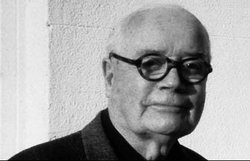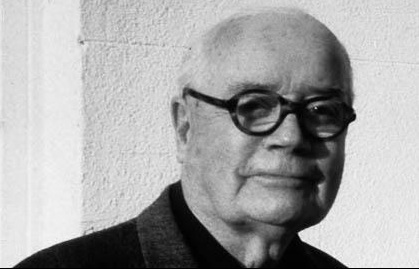Jellicoe was born in Chelsea. He studied at the Architectural Association in London in 1919 and won a Rome Scholarship in 1923 which enabled him to research his first book Italian Gardens of the Renaissance with John C. Shepherd. This pioneering study did much to re-awaken interest in this great period of landscape design and through its copious photographic illustrations publicized the then perilously decayed condition of many of the gardens. In 1929 he was a founding member of the Landscape Institute and from 1939-49 he was its President. In 1948 he became the founding President of the International Federation of Landscape Architects (IFLA). From 1954-68 he was a member of Royal Fine Art Commission and from 1967-74 a Trustee of Tate Gallery. He died in 1996, the best-known English landscape architect of his generation.
Source: Wikipedia
~~~~~~~~~~~~~~~~~~~~~~~~~~~
Sir Geoffrey Jellicoe
Born - Died : 1900 - 1996
Geoffrey Alan Jellicoe was an English architect, town planner, landscape architect and garden designer. His strongest interest was in landscape and garden design. Geoffrey Jellicoe studied at the Architectural Association in London and later became its principal. His book on Italian Gardens of the Renaissance (1925) led to a commission for the design of the garden at Ditchley Park. Two of Geoffrey Jellicoe's favourite projects are freely open to the public: The Water Garden in Hemel Hempsted and the Kennedy Memorial in Runnymede. Geoffrey Jellicoe's most ambitious English garden design was for Sutton Place in Surrey. In the longer term it is likely that Jellicoe, like Repton, will be valued even more as a landscape theorist than as a landscape designer. Jellicoe had a vast knowledge of landscape design history, as demonstrated by his book on The Landscape of Man, and was keenly interested in applying this knowledge to landscape design projects, as explained in his 3 volume Studies in Landscape Design and in his Guelph Lectures on Landscape Design. Educated in same school as Calvert Vaux (London's Architectural Association), Jellicoe was one of the first to appreciate the shortcomings of a Modernist design approach and arguably became the first Postmodern landscape and garden designer. His friendship with a number of leading modern artists led to an interest in Carl Jung and to Jellicoe's interest in the role of the subconscious in landscape design [see Geoffrey Jellicoe Edited by Sheila Harvey LDT monographs, 1998, ISBN 0 9518377].
Source: The Garden and Landscape Guide
~~~~~~~~~~~~~~~~~~~~~~~~~~~~~
Geoffrey Alan Jellicoe was born in London in 1900. He attended the Architectural Association School of Architecture in Bloomsbury, London from 1919 until 1923. He then went to Italy, where he and Jock Shepherd collected material for a book, Italian Gardens of the Renaissance (1925). Soon afterwards they set up a practice together, but in 1931 Jellicoe set up his own firm.
In 1936, Jellicoe married Ursula Susan Pares, his multi-lingual, greatly over-qualified secretary. The two of them collaborated professionally throughout the course of their 50-year marriage.
In 1929 Jellicoe was a founder member of the Institute of Landscape Architects, of which he was president for a decade from 1939. He was also principal of the Architectural Association School from 1939 to 1942 and first president of the International Federation of Landscape Architects from 1948 to 1954.
From 1954, Jellicoe was in practice with Francis Coleridge, doing mainly architectural work. Sites included the Hope cement works in the Peak district, water gardens at Hemel Hempstead and Harvey's department store in Guildford.
Jellicoe was also a collector of contemporary art and served on the Royal Fine Arts Commission. He became interested in the subconscious in landscape design, which influenced his layout of the Kennedy Memorial at Runnymede. Between 1960 and 1970, he published his three-volume Studies in Landscape Design, which looked at connections between landscapes, art and hidden ideas. His seminal work The Landscape of Man was published in 1975.
His creativity continued into his eighties, although he had dissolved the architectural practice in 1973. He continued to work at home, alongside nursing his wife through Parkinson's disease, from which she died in 1986. He gained the CBE in 1961 and a knighthood in 1979. In 1991 he was elected a Royal Academian and in 1994 held an exhibition there. He achieved Landscape Architects' gold medals in 1981, 1985 and 1990 and gained the Royal Horticultural Society's Victoria medal of honour in 1995. He died in Devon in 1996.
Source: Parks and Gardens UK
Jellicoe was born in Chelsea. He studied at the Architectural Association in London in 1919 and won a Rome Scholarship in 1923 which enabled him to research his first book Italian Gardens of the Renaissance with John C. Shepherd. This pioneering study did much to re-awaken interest in this great period of landscape design and through its copious photographic illustrations publicized the then perilously decayed condition of many of the gardens. In 1929 he was a founding member of the Landscape Institute and from 1939-49 he was its President. In 1948 he became the founding President of the International Federation of Landscape Architects (IFLA). From 1954-68 he was a member of Royal Fine Art Commission and from 1967-74 a Trustee of Tate Gallery. He died in 1996, the best-known English landscape architect of his generation.
Source: Wikipedia
~~~~~~~~~~~~~~~~~~~~~~~~~~~
Sir Geoffrey Jellicoe
Born - Died : 1900 - 1996
Geoffrey Alan Jellicoe was an English architect, town planner, landscape architect and garden designer. His strongest interest was in landscape and garden design. Geoffrey Jellicoe studied at the Architectural Association in London and later became its principal. His book on Italian Gardens of the Renaissance (1925) led to a commission for the design of the garden at Ditchley Park. Two of Geoffrey Jellicoe's favourite projects are freely open to the public: The Water Garden in Hemel Hempsted and the Kennedy Memorial in Runnymede. Geoffrey Jellicoe's most ambitious English garden design was for Sutton Place in Surrey. In the longer term it is likely that Jellicoe, like Repton, will be valued even more as a landscape theorist than as a landscape designer. Jellicoe had a vast knowledge of landscape design history, as demonstrated by his book on The Landscape of Man, and was keenly interested in applying this knowledge to landscape design projects, as explained in his 3 volume Studies in Landscape Design and in his Guelph Lectures on Landscape Design. Educated in same school as Calvert Vaux (London's Architectural Association), Jellicoe was one of the first to appreciate the shortcomings of a Modernist design approach and arguably became the first Postmodern landscape and garden designer. His friendship with a number of leading modern artists led to an interest in Carl Jung and to Jellicoe's interest in the role of the subconscious in landscape design [see Geoffrey Jellicoe Edited by Sheila Harvey LDT monographs, 1998, ISBN 0 9518377].
Source: The Garden and Landscape Guide
~~~~~~~~~~~~~~~~~~~~~~~~~~~~~
Geoffrey Alan Jellicoe was born in London in 1900. He attended the Architectural Association School of Architecture in Bloomsbury, London from 1919 until 1923. He then went to Italy, where he and Jock Shepherd collected material for a book, Italian Gardens of the Renaissance (1925). Soon afterwards they set up a practice together, but in 1931 Jellicoe set up his own firm.
In 1936, Jellicoe married Ursula Susan Pares, his multi-lingual, greatly over-qualified secretary. The two of them collaborated professionally throughout the course of their 50-year marriage.
In 1929 Jellicoe was a founder member of the Institute of Landscape Architects, of which he was president for a decade from 1939. He was also principal of the Architectural Association School from 1939 to 1942 and first president of the International Federation of Landscape Architects from 1948 to 1954.
From 1954, Jellicoe was in practice with Francis Coleridge, doing mainly architectural work. Sites included the Hope cement works in the Peak district, water gardens at Hemel Hempstead and Harvey's department store in Guildford.
Jellicoe was also a collector of contemporary art and served on the Royal Fine Arts Commission. He became interested in the subconscious in landscape design, which influenced his layout of the Kennedy Memorial at Runnymede. Between 1960 and 1970, he published his three-volume Studies in Landscape Design, which looked at connections between landscapes, art and hidden ideas. His seminal work The Landscape of Man was published in 1975.
His creativity continued into his eighties, although he had dissolved the architectural practice in 1973. He continued to work at home, alongside nursing his wife through Parkinson's disease, from which she died in 1986. He gained the CBE in 1961 and a knighthood in 1979. In 1991 he was elected a Royal Academian and in 1994 held an exhibition there. He achieved Landscape Architects' gold medals in 1981, 1985 and 1990 and gained the Royal Horticultural Society's Victoria medal of honour in 1995. He died in Devon in 1996.
Source: Parks and Gardens UK
Sponsored by Ancestry
Advertisement
Advertisement


